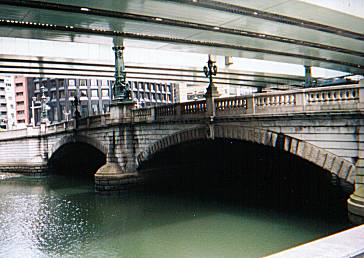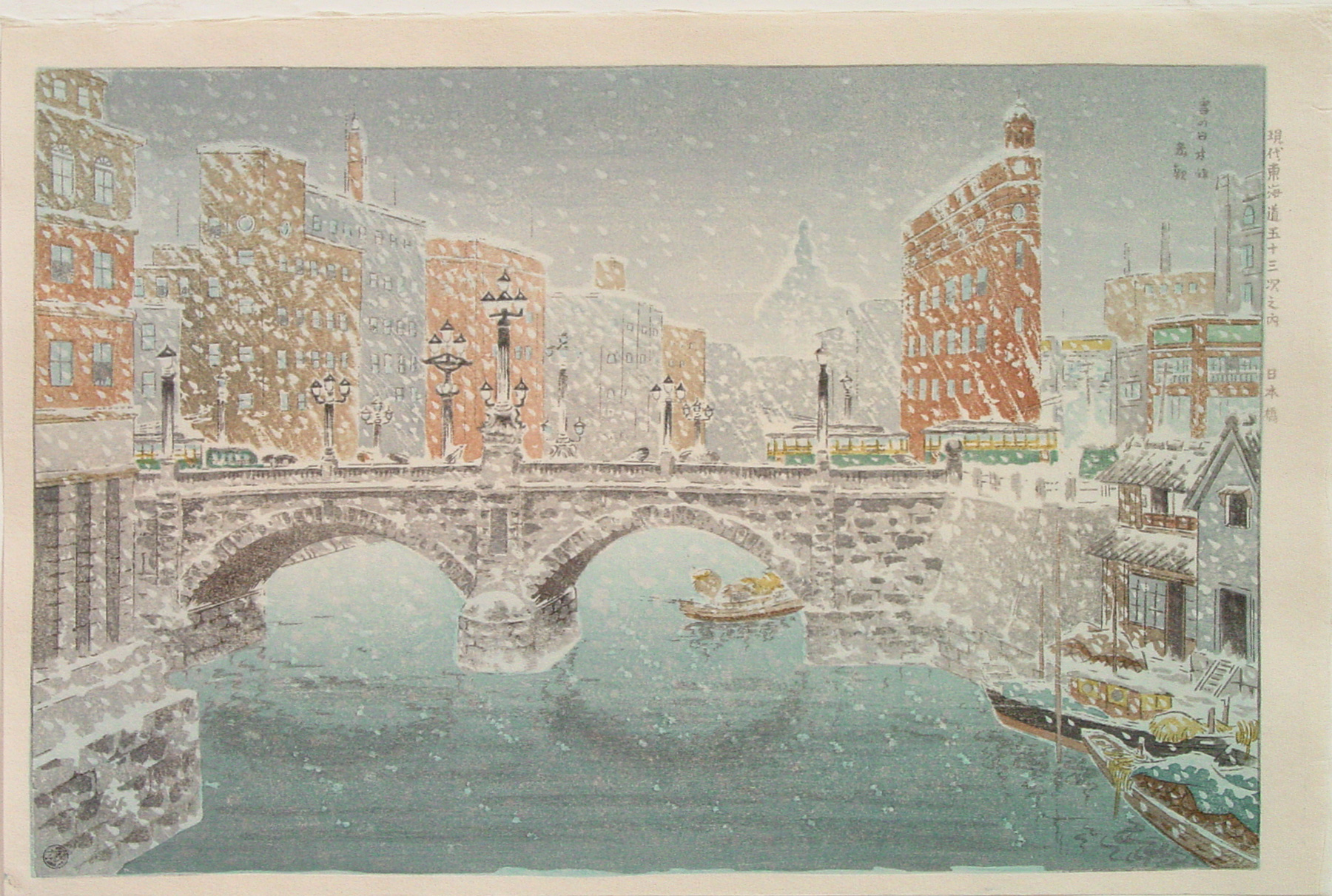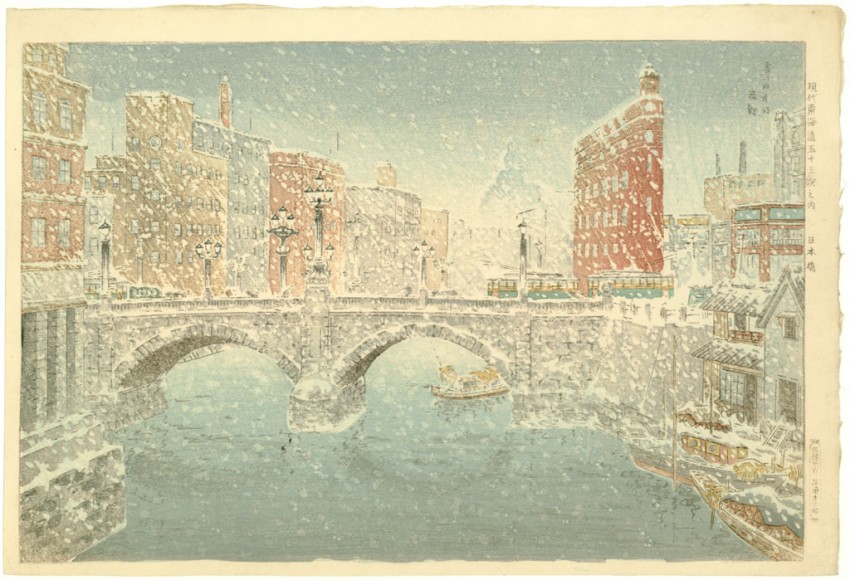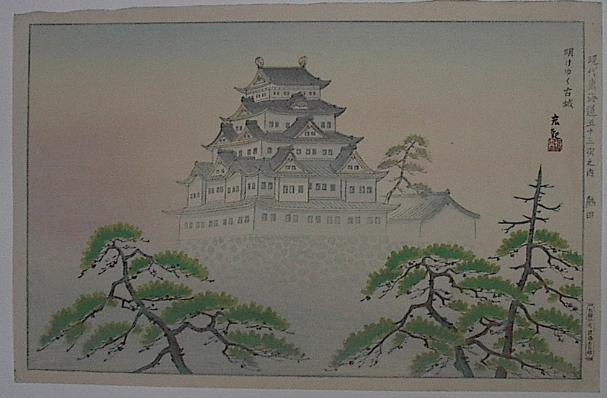About This Print
Source: Shin-Hanga: New Prints inModern Japan, Kendall Brown, Hollis Goodall-Cristante, Los Angeles County Museum of Art, 1996, p. 110 and 82, fig. 110 and as footnoted.Nihon Bridge in Snow by Bannai Kōkan (1900-1963) presents the actual appearance of Nihonbashi but then hides its true face behind a blizzard. Kōkan, a painter who produced prints for the publisher Watanabe Shōzaburō (1885-1962) in the 1930s, designed this scene as the first work in a proposed, but not realized, series, Fifty-three Modern Views of the Tōkaidō.
The other two prints realized in the series are Atsuta-Old Castle at Dawn and Lake Ashinoko, Hakone.1 (See reference images below.)
The full print title is at the upper right corner of the composition, Yuki no Nihonbashi, followed by the artist's name, Kōkan. The series title with a shortened print title (lacking 'no yuki') appears along the right-hand margin, Gendai tōkaidō gojusan tsugi no uchi, Nihonbashi.
The full print title is at the upper right corner of the composition, Yuki no Nihonbashi, followed by the artist's name, Kōkan. The series title with a shortened print title (lacking 'no yuki') appears along the right-hand margin, Gendai tōkaidō gojusan tsugi no uchi, Nihonbashi.
This collection's print is a later, likely post-1957 or Heisei era edition by Watanabe. An earlier, and possibly first, edition of the print is shown below.
1 As listed on the website of The National Museum of Modern Art, Tokyo
1 As listed on the website of The National Museum of Modern Art, Tokyo
An Early Edition with Watanabe "D" Seal
This print shown on the website of Hotei Japanese Prints
displays the Watanabe "D" type seal in the lower part of the
right margin, indicating the print was published between
1929 and 1942. It is, very possibly, a first edition.
The Other Two Prints Realized in the Series
Nihon Bridge
The Nihon Bridge, built in 1911, is a double-arched stone bridge in the Renaissance style. It was designated as a cultural heritage of Japan in 1999. The original bridge made of wood was built in 1603, at the beginning of the Edo period. The middle of the bridge has been the starting point of five main roads since then, including the Tokaido Road which led to Kyoto. Some of the Metropolitan Expressways in Tokyo were built on waterways at the sacrifice of the riverside scenery in 1960's. You can take shelter from the rain on this famous bridge, for it is completely covered by an expressway.
Print Details
| IHL Catalog | #35 |
| Title or Description | Nihon Bridge in Snow Yuki no Nihon-bashi 雪の日本橋 |
| Series | Fifty-three Modern Views of the Tōkaidō Gendai Tōkaidō gojūsan tsugi 現代東海道五十三次 |
| Artist | Bannai Kōkan (1900-1963) |
| Signature | Kōkan in upper right of image |
| Seal | not sealed |
| Publication Date | c. 1930 original publication date |
| Edition | Post-1957 edition with Watanabe publisher 7mm round seal type "I" |
| Publisher | Watanabe Shōzaburō I-type 7mm round seal reading ワタナベ I-type 7mm round seal reading ワタナベ[Marks: seal 08-034; pub. ref. 576] |
| Carver | |
| Printer | |
| Impression | excellent |
| Colors | excellent |
| Condition | excellent |
| Miscellaneous | a panorama of Nihonbashi with the streetcar crossing and the 1914 Daiei Building. |
| Genre | shin hanga (new prints) |
| Format | Oban tate-e |
| H x W Paper | 10 3/8 x 15 1/2 in. (26.4 x 39.4 cm) |
| H x W Image | 9 3/8 x 14 1/4 in. (23.8 x 36.2 cm) |
| Collections This Print | Los Angeles County Museum of Modern Art M.73.37.523 (unspecified edition and no publisher seal can be discerned on the thumbnail image of print); Museum of Fine Arts, Boston 353.2057 (unspecified edition); The National Museum of Modern Art, Tokyo M00100-001 (unspecified edition); Carnegie Museum of Art 89.28.241 (unspecified edition with round Watanabe publisher seal of unspecified diameter in lower left corner); Mead Art Museum, Amherst College AC 2010.132 (Heisei seal) |
| Reference Literature | Shin-Hanga: New Prints in Modern Japan, Kendall Brown, Hollis Goodall-Cristante, Los Angeles County Museum of Art, 1996, p. 82, Fig. 110; Modern Japanese Prints: The Twentieth Century, Amanda T. Zehnder, Carnegie Museum of Art, 2009, p. 23. |





